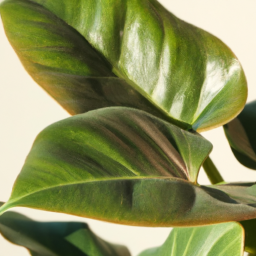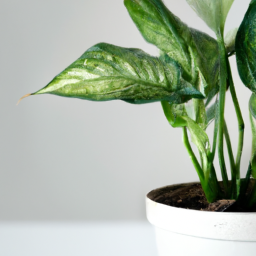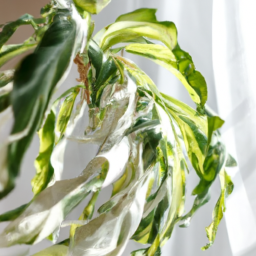
Hey there! Have you ever wondered how you can improve the air quality in your home? Well, look no further because in this blog post, we’ll be diving into the world of indoor plants for air purification. Yes, you heard it right – these green wonders not only add a touch of nature to your living space but also work their magic in filtering out harmful toxins from the air. So, if you’re ready to create a healthier and more refreshing environment indoors, let’s explore the world of indoor plants and their incredible air-purifying abilities.
Benefits of Indoor Plants for Air Purification
Indoor plants not only add beauty and tranquility to our living spaces but also play a vital role in purifying the air we breathe. In today’s world, where air pollution is a growing concern, having indoor plants can significantly improve the quality of the air inside our homes and offices. Let’s dive into the fascinating benefits of indoor plants for air purification.
1. Removal of Harmful Chemicals
Indoor air can be filled with various harmful chemicals emitted from household products, furniture, and cleaning agents. These chemicals, known as volatile organic compounds (VOCs), can have detrimental effects on our health, leading to respiratory issues, allergies, and even long-term diseases. However, certain indoor plants have the incredible ability to absorb and neutralize these harmful chemicals.
One such plant is the Peace Lily (Spathiphyllum), which is not only aesthetically pleasing but also highly effective in removing VOCs like formaldehyde, benzene, and trichloroethylene from the air. Its lush green leaves and elegant white flowers make it a perfect addition to any indoor space, while its air-purifying qualities make it a top choice for those concerned about their well-being.
Another remarkable plant for eliminating VOCs is the Snake Plant (Sansevieria trifasciata). This resilient plant can thrive in low-light conditions and requires minimal care, making it ideal for busy individuals. It releases oxygen at night while absorbing carbon dioxide, making it an excellent choice for bedrooms where air quality is crucial during sleep.
Furthermore, the Boston Fern (Nephrolepis exaltata) is renowned for its air-purifying abilities. It effectively removes pollutants like formaldehyde and xylene, which are commonly found in household products and paints. This vibrant green plant with delicate fronds can bring a touch of nature indoors while enhancing the air quality.
2. Increased Oxygen Production
One of the most well-known benefits of indoor plants is their ability to produce oxygen through photosynthesis. This process involves plants absorbing carbon dioxide and releasing oxygen, thus improving the air quality in our surroundings.
A particularly efficient plant in oxygen production is the Areca Palm (Dypsis lutescens). This tropical beauty not only adds a touch of elegance to any room but also releases a significant amount of moisture into the air, making it ideal for dry environments. With its high oxygen output, the Areca Palm can boost the overall air quality, making it easier to breathe and promoting a sense of well-being.
The Rubber Plant (Ficus elastica) is another fantastic choice for increasing oxygen levels indoors. Its large, glossy leaves not only make a bold statement but also contribute to a healthier living environment. The Rubber Plant is known for its ability to remove toxins from the air while releasing oxygen, making it a valuable addition to any indoor space.
Moreover, the English Ivy (Hedera helix) is a versatile plant that not only purifies the air but also helps reduce mold levels. It has been found to be particularly effective in removing airborne mold particles, making it an excellent choice for individuals with respiratory conditions or allergies.
3. Improved Humidity and Moisture Balance
Indoor spaces often suffer from low humidity, especially during the winter months when heating systems are in use. This dry environment can lead to respiratory problems, dry skin, and even damage to wooden furniture. However, certain indoor plants can act as natural humidifiers, restoring the moisture balance and creating a more comfortable living environment.
The Peace Lily, in addition to its air-purifying qualities, is known for its ability to increase humidity levels. Its large leaves release moisture into the air, making it an excellent choice for dry climates or spaces with low humidity.
The Spider Plant (Chlorophytum comosum) is another plant that can effectively increase humidity levels. With its cascading green and white leaves, it adds a touch of elegance to any room while helping to combat dryness. The Spider Plant is also known for its air-purifying properties, making it a double threat when it comes to improving indoor air quality.
Last but not least, the Chinese Evergreen (Aglaonema) is a popular choice for improving humidity levels. This low-maintenance plant thrives in low-light conditions and can tolerate a wide range of temperatures. Its lush foliage not only adds beauty to any space but also helps maintain optimal humidity levels for a healthier living environment.
In conclusion, indoor plants offer numerous benefits for air purification. From removing harmful chemicals to increasing oxygen levels and improving humidity balance, these green companions play a crucial role in creating a healthier and more enjoyable indoor environment. So why not bring the beauty of nature indoors and reap the rewards of cleaner and fresher air?

Best Indoor Plants for Improving Air Quality
Welcome to our guide on indoor plants for air purification! In this article, we will explore some of the best indoor plants that can help improve the air quality in your home or office. Indoor plants not only add beauty to your space but also act as natural air purifiers by removing harmful toxins and releasing oxygen. So, let’s dive in and discover the perfect plants for a healthier indoor environment.
1. Snake Plant (Sansevieria trifasciata)
The Snake Plant, also known as Mother-in-Law’s Tongue, is a popular choice for indoor air purification. It is a low-maintenance plant that thrives in various lighting conditions, making it suitable for both bright and low-light areas. The Snake Plant is particularly effective at removing formaldehyde, a common indoor pollutant found in cleaning products, furniture, and carpets.
Aside from its air-purifying qualities, the Snake Plant is also known for its ability to release oxygen during the night, making it an ideal bedroom plant. It has long, upright leaves that come in different shades of green, providing an aesthetic appeal to any space.
To care for your Snake Plant, place it in well-draining soil and water it sparingly. It can tolerate drought-like conditions, so be careful not to overwater it. This plant is a great addition to any indoor environment, especially if you are new to plant care.
2. Peace Lily (Spathiphyllum)
The Peace Lily is not only visually stunning with its elegant white flowers but also a powerful air purifier. It effectively removes toxins like benzene, formaldehyde, and trichloroethylene from the air, making it a fantastic choice for improving indoor air quality.
This plant thrives in low to medium light conditions and prefers to be kept slightly moist. It is important to note that the Peace Lily is toxic to pets if ingested, so it should be placed in an area that is out of reach for your furry friends.
When caring for your Peace Lily, keep an eye on its leaves. If they start to droop, it’s a sign that the plant needs watering. However, be careful not to overwater it, as this can lead to root rot. With proper care, the Peace Lily will not only enhance the air quality but also add a touch of elegance to your indoor space.
3. Boston Fern (Nephrolepis exaltata)
The Boston Fern is a lush and leafy plant that not only adds beauty to your indoor space but also acts as a natural air humidifier. It is highly effective at removing formaldehyde, xylene, and toluene from the air, making it an excellent choice for purifying the air in your home or office.
This plant prefers bright, indirect light and high humidity levels. To keep your Boston Fern happy, mist its leaves regularly or place a tray of water nearby to increase humidity. Ensure that the soil remains consistently moist but not waterlogged.
When it comes to fertilizing, use a balanced liquid fertilizer once a month during the growing season. The Boston Fern requires a bit more care compared to other plants on this list, but its air-purifying and aesthetic benefits make it worth the effort.
Conclusion
Indoor plants can significantly improve the air quality in your home or office by reducing the levels of harmful toxins. The Snake Plant, Peace Lily, and Boston Fern are just a few examples of plants that excel at air purification. Remember to choose plants that suit your lighting conditions and lifestyle, and always provide them with proper care.
By incorporating these indoor plants into your space, you can create a healthier and more enjoyable environment to live or work in. So go ahead, bring some greenery indoors, and breathe in the fresh air!

Tips for Maintaining Indoor Plants for Air Purification
Introduction
Welcome to the world of indoor plants, where nature meets your living space! Indoor plants not only add beauty and freshness to your home but also play a crucial role in purifying the air you breathe. These green companions have the amazing ability to filter out harmful toxins and release oxygen, making your indoor environment healthier and more enjoyable.
In this guide, we will explore some essential tips for maintaining indoor plants specifically for air purification. Whether you’re a beginner or a seasoned plant enthusiast, these tips will help you create a thriving indoor garden that not only enhances your decor but also provides you with cleaner and fresher air.
Choosing the Right Indoor Plants
The first step in maintaining indoor plants for air purification is selecting the right plants for your space. Not all plants are equal when it comes to air-purifying abilities. Some plants are more efficient at removing toxins from the air than others. Here are a few popular choices:
1. Snake Plant (Sansevieria trifasciata): This low-maintenance plant is known for its ability to absorb toxins like formaldehyde and benzene. It thrives in a variety of lighting conditions and is perfect for beginners.
2. Peace Lily (Spathiphyllum): With its beautiful white flowers, the peace lily not only adds elegance to your space but also filters out harmful substances like ammonia, formaldehyde, and benzene. It prefers low to medium light and moderate watering.
3. Boston Fern (Nephrolepis exaltata): This lush green fern is an excellent choice for removing formaldehyde, xylene, and toluene from the air. It loves indirect light and high humidity, making it ideal for bathrooms or kitchens.
Providing the Right Environment
Once you’ve chosen the perfect indoor plants for air purification, it’s crucial to create an environment that allows them to thrive. Here are some tips to ensure your plants stay healthy:
1. Lighting: Most indoor plants thrive in bright, indirect light. Place them near windows or provide them with artificial grow lights if natural light is limited. Avoid exposing them to direct sunlight, as it can scorch their leaves.
2. Temperature and Humidity: Indoor plants generally prefer temperatures between 60-75°F (15-24°C). They also thrive in moderate humidity levels, so consider using a humidifier or placing a tray of water near your plants to increase humidity.
3. Watering: Proper watering is vital for the health of your indoor plants. Overwatering can lead to root rot, while underwatering can cause wilting and stunted growth. Check the soil moisture regularly and water your plants when the top inch of soil feels dry. Use room temperature water and ensure proper drainage to prevent waterlogging.
Caring for Your Indoor Plants
Regular care and maintenance are essential for the longevity of your indoor plants. Follow these tips to keep them thriving:
1. Pruning: Regularly prune your plants to remove dead or yellowing leaves. This not only improves their appearance but also promotes new growth.
2. Fertilizing: Indoor plants benefit from occasional fertilization to provide them with essential nutrients. Use a balanced, water-soluble fertilizer and follow the instructions on the package for application.
3. Pest Control: Keep an eye out for common indoor plant pests like aphids, spider mites, and mealybugs. If you notice any signs of infestation, treat the affected plants with organic pest control solutions or consult a professional for advice.
Remember, each plant has its own specific care requirements, so it’s essential to research and understand the needs of the plants you choose to ensure their optimal growth and air-purifying capabilities.
Conclusion
Indoor plants not only add beauty to your home but also contribute to cleaner and healthier air. By choosing the right plants, providing the right environment, and caring for them diligently, you can create an indoor oasis that not only enhances your well-being but also purifies the air you breathe. So, go ahead and bring nature indoors by incorporating air-purifying plants into your living space. Your lungs will thank you!
Key Takeaways
Indoor Plants for Air Purification
If you’re looking to improve the air quality in your home, look no further than indoor plants. Not only do they add a touch of greenery to your space, but they also have the incredible ability to filter and purify the air we breathe. So, which plants should you choose? Let’s explore some of the best indoor plants for air purification.
First on the list is the ever-popular Snake Plant, also known as Mother-in-Law’s Tongue. This plant is a champion when it comes to filtering out toxins like formaldehyde and benzene. It’s also known for its ability to convert carbon dioxide into oxygen during the night, making it an excellent choice for bedrooms. Another great option is the Peace Lily, a beautiful plant that thrives in low-light conditions. Not only does it remove harmful chemicals like ammonia and acetone from the air, but it also helps to increase humidity levels, creating a more comfortable environment. Lastly, we have the Boston Fern, a classic choice for air purification. This plant is highly effective at removing formaldehyde, xylene, and toluene from the air. Plus, its lush foliage adds a touch of elegance to any room.
Common Questions and Answers:
Q1: What are the best indoor plants for air purification?
A1: There are several indoor plants that are known for their air purifying qualities. Some popular choices include the snake plant, pothos, spider plant, peace lily, and aloe vera. These plants have the ability to remove harmful toxins from the air and improve indoor air quality.
Q2: How do indoor plants purify the air?
A2: Indoor plants purify the air through a process called phytoremediation. They absorb pollutants from the air through their leaves and roots, and then convert them into nutrients for their own growth. This natural process helps to remove harmful chemicals and toxins, making the air cleaner and healthier to breathe.
Q3: How many indoor plants do I need for air purification?
A3: The number of indoor plants you need for air purification depends on the size of your space and the specific plants you choose. As a general guideline, it is recommended to have one medium-sized plant (6-8 inch pot) per 100 square feet of space. However, you can always add more plants if you desire or if you have larger rooms.
Q4: Can indoor plants really improve indoor air quality?
A4: Yes, indoor plants can indeed improve indoor air quality. Numerous studies have shown that certain plants have the ability to remove common air pollutants such as formaldehyde, benzene, and trichloroethylene. While plants alone may not be able to completely purify the air, they can certainly contribute to a healthier indoor environment when combined with proper ventilation and other air purification methods.
Q5: Do indoor plants require any special care for air purification?
A5: Indoor plants for air purification generally require the same care as any other indoor plant. They need proper watering, adequate sunlight or artificial light, and occasional fertilization. It’s also important to regularly dust the leaves to ensure optimal air purification. Additionally, avoid overwatering to prevent mold growth, as this can negatively impact air quality.

James Wong is a renowned ethnobotanist, plant scientist, and local television presenter. With a passion for demystifying plant science, he is known for translating complex botanical concepts into practical advice for everyday plant enthusiasts. James’s expertise spans from traditional gardening to cutting-edge plant technologies, making his insights accessible and informative.


